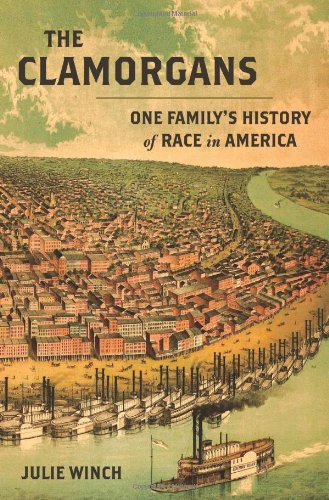Last week, I picked up an advanced review copy of Julie Winch's The Clamorgans: One Family's History of Race in America (New York: Hill and Wang, 2011) from the free book cart at work. It was a relatively quick, though also a bit daunting, read. Winch, an historian based at the University of Massachusetts - Boston, focuses on the "lives and genealogies" of African-Americans in the Revolutionary War era and the period of the Early Republic. Her previous books focus on elite black families and individuals in Philadelphia; in The Clamorgans she turns her attention to a multiracial family based in St. Louis, beginning in the decades before the Louisiana Purchase (1803) and navigating its labyrinthian way to the mid-twentieth century.
The Clamorgan clan, at least as Winch documents it, began with a French entrepeneur (read: shady financial speculator) named Jacques Clamorgan in the 1780s, who settled in St. Louis when it was still (nominally) part of the Spanish empire. He had a number of children by three different women, all of whom were black and during one point during their lives were enslaved (some owned by Jacques himself). From this root, Winch traces in exhaustively-documented detail the fates of the descendents of this family tree. She is aided by the fact that Jacques Clamorgan was a litigious man who turned to the courts whenever he was unhappy with how his affairs (financial and familial) had been settled ... and that his children and grandchildren and great-grandchildren followed suit. Jacques died in the early 1800s with extensive land claims, which he had finessed from the Spanish administrators, left unresolved following the Louisiana Purchase and the entrance of St. Louis and its environs into the expanding boundaries of the United States. For subsequent generations, these land claims became the promise of riches they turned to again and again whenever their (rapidly rising and falling) fortunes waivered.
The Clamorgan story is one not only of economic and social class but, inevitably, also a story of race, since all of Jacques Clamorgan's descendents were in some measure mixed race, and often able to "pass" as white or of Native American ancestory. In a period where black and white society was so sharply divided, the relative ease of each Clamorgan descendent to move with ease in and out of white and black communities directed effected their economic and social fortunes. Some Clamorgans chose (or had no option other than) to rise to the top of the black elite in St. Louis or other locales around North and Central America. Other branches of the family were light-skinned enough that they attempted to cross the racial divide and pass themselves and their children off as "white," usually for specific social and economic advancement (access to "white" jobs, schools, and neighborhoods).
The strength of this book is the sheer volume of research Winch has undertaken (I imagine with a bevy of student assistants and a very good data management system, though I could be mistaken!). Through the minute details offered up in court documents, newspaper columns, census records, and other archival sources Winch opens a window for readers onto the gritty details of how one specific American family struggled to gain a viable foothold in the volatile economic climate of the nineteenth century. Anyone who claims that our "addiction" to credit or predatory lending is an invention of our current epoch really just exposes themselves as a poor student of economic history: lines of credit, properties bought and sold on speculation, double-dealing lawyers -- all of these make more than cameo appearances in The Clamorgans saga.
What I found myself wishing for more of, as both a reader-for-pleasure and an historian, was more analysis and context. Winch provides us with a rich narrative of one family's history ... what I wanted to know was how their journey up and down the economic ladder and back and forth across the color line fit into broader national patterns. Was their story typical? Atypical? How so? Was their recourse to the law usual for the time and place in which they lived, or did it set them apart? What contribution does the Clamorgan family story make to our understanding of how race and class (and to a lesser extent, though indubitably present, gender) function in American society? How do all of the details Winch has uncovered about the Clamorgan clan inform the work of other historians on these topics? Do they fit into previous hypotheses about how social categories functioned during this period, or do they challenge those interpretations in new ways? It was this historiographical discussion that I found myself missing. I hope that historians who utilize Winch's work in the future will be able to fill this gap in the scholarship.
Final verdict: Incredibly useful for historians who are studying this period or topics related to the history of race and class in America ... engaging for anyone else who is willing to put in the effort to keep the sprawling clan Clamorgan straight for however long it takes to read the book!

No comments:
Post a Comment